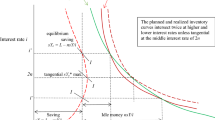Abstract
In this paper the focus is on characterizing and computing the probabilities of ruin in three mathematical models arising in economics. First, we examine a credit system in which small loans without collaterals are extended to a large number of costumers, and study the probability of collapse due to defaults. Next, we consider a Walrasian model of an exchange economy in which the endowments are random, and analyze the probability that at equilibrium prices an agent does not have the minimum income needed for survival. Finally, the problem of sustaining a constant consumption of a resource the stock of which is augmented by a random input is considered. The steady state of the resulting Markov process, the speed at which it is approached, and the possibility of exhaustion of the stock are examined.
Similar content being viewed by others
References
Aghion, B.A. and Murdoch, J. (2007). The Economics of Microfinance. MIT Press, Cambridge.
Amari, S.V. and Misra, R.B. (1997). Closed form expression for distribution of sum of exponential random variables. IEEE Trans. Reliab., 46, 519–522.
Asmussen, S. (1998). Subexponential asymptotics for stochastic processes: extremal behavior, stationary distributions and first passage probabilities. Ann. Appl. Probab., 8, 354–374.
Bacro, J.N., Daudin, J.J., Mercier, S. and Robin, S. (2002). Back to the local score in the logarithmic case: a direct and simple proof. Ann. Inst. Statist. Math., 54, 748–757.
Bahadur, R. and Ranga Rao, R. (1960). On deviations of the sample mean. Ann. Math. Statist., 31, 1015–1027.
Bhattacharya, R.N. and Majumdar, M. (1973). Random exchange economies. J. Econ. Theory, 6, 37–67.
Bhattacharya, R.N. and Majumdar, M. (2001). On characterizing the probability of survival in a large competitive economy. Rev. Econ. Des., 6, 133–153.
Bhattacharya, R.N. and Majumdar, M. (2007). Random Dynamical Systems: Theory and Applications. Cambridge University Press, Cambridge.
Bhattacharya, R.N. and Ranga Rao, R. (2010). Normal Approximation and Asymptotic Expansions. Classics in Applied Mathematics, vol. 64. SIAM, Philadelphia.
Bhattacharya, R.N. and Waymire, E.C. (2007). A Basic Course in Probability Theory. Universitext. Springer, New York.
Bhattacharya, R.N., Majumdar, M. and Hashimzade, N. (2010). Limit theorems for monotone Markov processes. Sankhya, 72-A, pp. 170–190.
Blackwell, D. and Hodges, J.L. (1959). The probability in the extreme tail of a convolution. Ann. Math. Statist., 30, 1113–1120.
Chernoff, H. (1952). A measure of asymptotic efficiency for tests of a hypothesis based on the sum of observations. Ann. Math. Statist., 23, 493–507.
Durrett, R. (1999). Essentials of Stochastic Processes. Springer, New York.
Embrechts, P., Kluppelberg, C. and Mikosch, T. (1997). Modelling Extreme Events for Insurance and Finance. Springer, Berlin.
Esseen, C.G. (1945). Fourier analysis of distribution functions. Acta. Math., 77, 1–125.
Feller, W. (1957). An Introduction to Probability Theory and Its Applications, vol. 1. Wiley, New York.
Feller, W. (1971). An Introduction to Probability Theory and Its Applications, vol. 2. Wiley, New York.
Galbraith, J.K. (1993). A Short History of Financial Euphoria. Penguin Viking, New York.
Ghatak, M. and Guinnane, T.W. (1999). The economics of lending with joint liability. J. Dev. Econ., 60, 195–228.
Hashimzade, N. (2006). Famines without shortages. Oxf. Econ. Pap., 58, 636–654.
Heath, D., Resnick, S. and Samorodnitsky, G. (1997). Patterns of buffer overflow in a class of queues with long memory in the input stream. Ann. Appl. Probab., 7, 1021–1057.
Iams, S. and Majumdar, M. (2010). Stochastic equilibrium: concepts and computations for Lindley processes. Int. J. Econ. Theory, 6, 47–56.
Karlin, S. and Altschul, S.F. (1990). Methods for assessing the statistical significance of molecular sequence features by using general scoring schemes. Proc. Natl. Acad. Sci. U.S.A., 87, 2264–2268.
Karlin, S. and Dembo, A. (1992). Limit distribution of maximal segmental score among Markov-dependent partial sums. Adv. Appl. Probab., 24, 113–140.
Karlin, S., Dembo, A. and Kawabata, T. (1990). Statistical composition of high-scoring segments from molecular sequences. Ann. Statist., 18, 571–581.
Lindley, D.V. (1952). The theory of queues with a single server. Math. Proc. Cambridge Philos. Soc., 48, 277–289.
Lund, R.B. and Tweedie, R.L. (1996). Geometric convergence rates of stochastically ordered Markov chains. Math. Oper. Res., 21, 182–194.
Majumdar, M. (2009). Equilibrium, Welfare, and Uncertainty: Beyond Arrow-Debreu. Routledge, London.
Murdoch, J. (1999). The microfinance promise. J. Econ. Lit., 37, 1569–1614.
Ramasubramanian, S. (2009). Lectures on Insurance Models. Hindustan Book Agency, New Delhi.
Rotar, V. (2007). Actuarial Models: The Mathematics of Insurance. Chapman and Hall, Boca Raton, FL.
Sen, A.K. (1981a). Ingredients of famine analysis: availability and entitlements. Q. J. Econ., 95, 433–464.
Sen, A.K. (1981b). Poverty and Famines: An Essay on Entitlement and Deprivation. Clarendon Press, Oxford.
Serfling, R.J. (1980). Approximation Theorems of Mathematical Statistics. Wiley, New York.
Spitzer, F. (1956). A combinatorial lemma and its application to probability theory. Trans. Amer. Math. Soc., 82, 323–339.
Author information
Authors and Affiliations
Corresponding author
Additional information
Research partially supported by NSF Grant DMS 1107053.
Rights and permissions
About this article
Cite this article
Bhattacharya, R., Majumdar, M. & Lin, L. Problems of ruin and survival in economics: applications of limit theorems in probability. Sankhya B 75, 145–180 (2013). https://doi.org/10.1007/s13571-013-0068-1
Received:
Revised:
Published:
Issue Date:
DOI: https://doi.org/10.1007/s13571-013-0068-1
Keywords and phrases
- Collapse of credit system
- survival under Walrasian equilibrium
- renewable resource management
- large deviations
- CLT
- Lindley process




